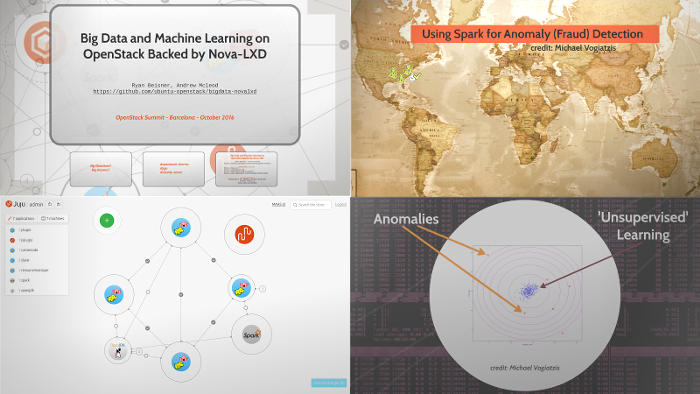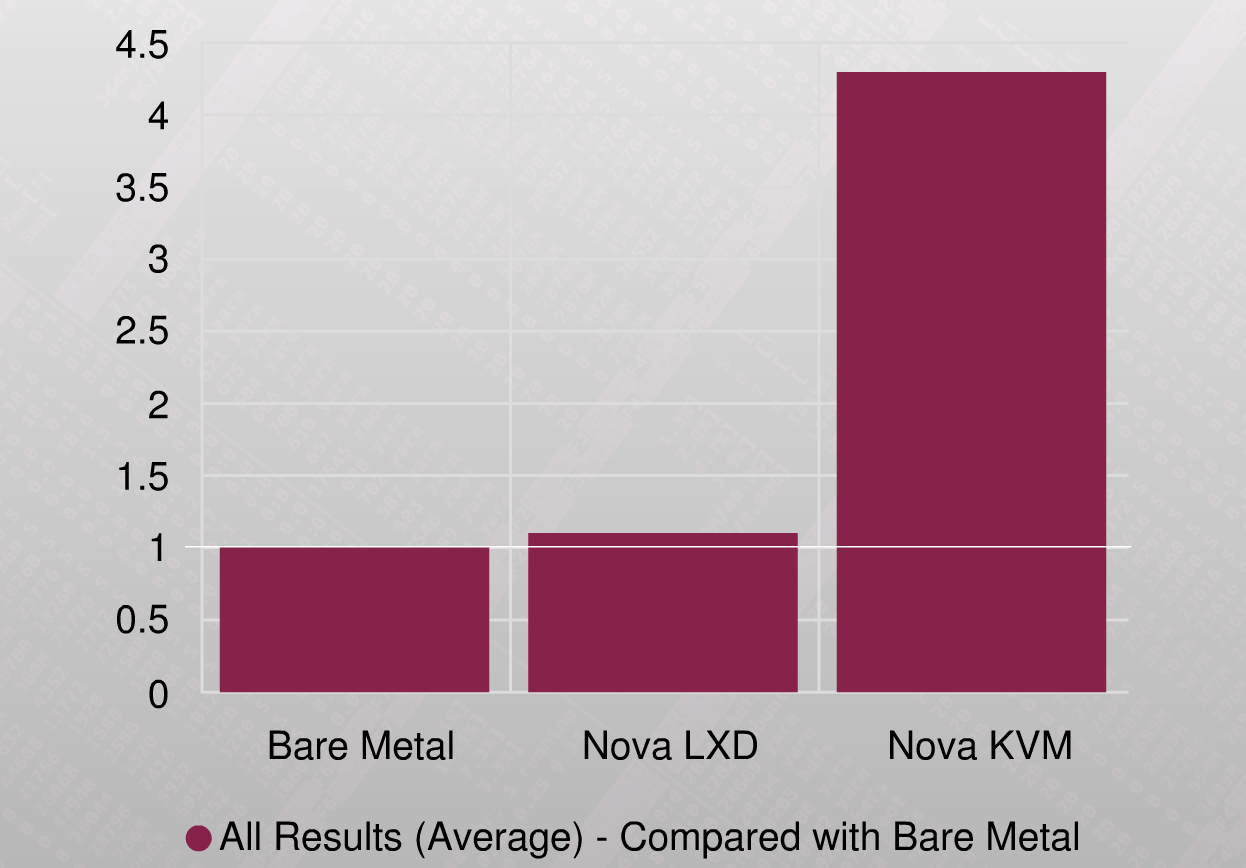Andrew McLeod [irc: admcleod] and Ryan Beisner [irc: beisner] for OpenStack Summit Barcelona 2016
Skip to Results: Bare Metal vs Nova-LXD vs Nova-KVM
Hadoop was built with bare metal in mind: get your commodity hardware, stick hadoop on it and let YARN do all the hard work managing resources. However, Big Data software deployments on other substrates such as AWS (ec2 and EMR), AZURE, GCE are gaining popularity.
We look at the challenges and a relevant solution related to deploying big data software in an OpenStack cloud. Perhaps most interestingly, we discuss and demonstrate what it looks like to run a machine learning job with Nova-LXD in that cloud to address data locality issues in virtualized environments, and to demonstrate that hypervisor overhead does not necessarily hinder Big/Fast Data processing.
A set of benchmark jobs and routines are executed against each of three different deployment substrates using the same set of identical hardware for each scenario.
We cover:
-
How to quickly and easily deploy a big data stack in an OpenStack cloud.
-
How we can use Big Data tools to run a machine learning job on OpenStack logs and detect anomalies such as unusual user login location - and scaling to handle increased traffic.
-
How Nova-LXD mitigates technical concerns about data-locality and hypervisor overhead in a virtualized environment.
-
Spark anomoly detection.
Deploy the big data applications onto three substrates: (1) bare metal; (2) OpenStack with Nova-LXD; (3) OpenStack with Nova-KVM -- each onto the same set of identical underlying physical machines.
Execute the same set of workloads and benchmarks against each big data deployment.
- Terasort Benchmark: The classic mapreduce benchmark - but this time, it's a gigasort.
- Anomoly Detection and Machine Learning Job - a Spark job which identifies financial transaction anomalies via unsupervised learning.
- Spark Hadoop Processing on MAAS bare metal
- Spark Hadoop Processing on Ubuntu OpenStack with Nova-LXD hypervisors
- Spark Hadoop Processing on Ubuntu OpenStack with Nova-KVM hypervisors
(12) Identical Dell PowerEdge R610 Machines
- (1) 2.40GHz Intel Xeon CPU E5620
- 48GB 1333MHz PC3-10600 CL9 ECC DDR3 SDRAM
- (2) Seagate ST9500620NS 500GB 7200 RPM 64MB SATA 6.0Gb/s Near-line Disks
- (4) Broadcom NetXtreme II Gigabit Ethernet
One machine is dedicated to MAAS, though that could be a much lesser machine or run within a container managed by LXD or a traditional KVM virtual machine. The remainder of the machines are allocated to the deployed workloads, such that there are the same number of Apache Hadoop Slaves with the same resources present in all three scenarios.
Each scenario (Bare Metal, Nova-LXD, and Nova-KVM) has exactly 5 Hadoop slaves, with each slave guaranteed exclusive placement per physical machine.
In the Nova scenarios, this is achieved by using exclusive machine scheduling filters and carefully-crafted flavors.
This approach presents a clean comparison of the workload and benchmarks of Nova-LXD against bare metal, and Nova-KVM against bare metal.
- Ubuntu Server 16.04 LTS
- OpenStack Mitaka
- OpenStack Charms
- Juju + MAAS
- Apache Bigtop Hadoop (HDFS and YARN) 2.7.1
- Apache Bigtop Spark version 1.5.1
- All Big Data and OpenStack applications and services are deployed onto Ubuntu 16.04 Xenial.
- OpenStack Newton was pre-RC at the time of this research and writing, so OpenStack Mitaka was selected.
The following is necesary and applicable to all scenaios.
- (11) machines are commissioned, enlisted, tagged as 'demo' and ready to deploy in MAAS.
- Juju is installed and configured to use MAAS.
- The bigdata-novalxd repo is locally cloned and is the current directory.
-
Run:
git clone https://github.com/ubuntu-openstack/bigdata-novalxd cd bigdata-novalxd
- Deploy Spark Hadoop Processing to bare metal with Juju, the Big Data Charms, and MAAS
-
Juju bundle: spark-hadoop-processing.yaml
-
Deployment script: deploy-spark-on-metal.sh
-
Run:
tools/deploy-spark-on-metal.sh
-
Spark Processing will deploy and announce the IP info for the YARN unit.
- Post-Deployment Routine
-
Run:
tools/run_all_tests.sh
- Deploy Ubuntu OpenStack to bare metal with Juju, the OpenStack Charms, and MAAS.
-
Juju bundle: openstack-nova-lxd.yaml
-
Deployment script: deploy-openstack-nova-lxd.sh
-
Run:
tools/deploy-openstack-nova-lxd.sh
-
OpenStack will deploy, configure and run basic checks.
- Deploy Spark Hadoop Processing to OpenStack with Juju and the Big Data Charms.
-
Juju bundle: spark-hadoop-processing.yaml
-
Deployment script: deploy-spark-on-openstack.sh
-
Run:
tools/deploy-spark-on-openstack.sh
-
Spark Processing will deploy and announce the IP info for the YARN unit.
-
Post-Deployment Routine
tools/run_all_tests.sh
- Deploy Ubuntu OpenStack to bare metal with Juju, the OpenStack Charms, and MAAS.
-
Juju bundle: openstack-nova-kvm.yaml
-
Deployment script: deploy-openstack-nova-kvm.sh
-
Run:
tools/deploy-openstack-nova-kvm.sh
-
OpenStack will deploy, configure and run a basic check.
- Deploy Spark Hadoop Processing to OpenStack with Juju and the Big Data Charms.
-
Juju bundle: spark-hadoop-processing.yaml
-
Deployment script: deploy-spark-on-openstack.sh
-
Run:
tools/deploy-spark-on-openstack.sh
-
Spark Processing will deploy and announce the IP info for the YARN unit.
-
Post-Deployment Routine
tools/run_all_tests.sh
The charms require firewall egress to the Ubuntu repositories, the Ubuntu Cloud Archive, and the Apache Bigtop repositories. Many of the deployed applications are sensitive to DNS. Ensure that the network provides DNS which allows units to resolve themselves and their peers with A and PTR records. Such configuration is out of the scope of this demonstration.
With:
- All compute nodes hosting exactly one Hadoop slave (nova instance);
- All Hadoop slaves being of the same instance size (nova flavor);
- All compute nodes comprised of the same set of physical machines;
- All physical machines being of identical make, spec and model; and
When considering averages of the Spark job and benchmark measurements:
-
The Nova-LXD-backed OpenStack was >2.9X (nearly three times) more performant in completing the analysis than the Nova-KVM-backed OpenStack.
-
The MAAS Bare Metal stack was >3.2X (over three times) more performant in completing the analysis than the Nova-KVM-backed OpenStack.
-
The 'Reduce' operations were >7X (over seven times) more performant with Nova-LXD than Nova-KVM.
-
The Nova-KVM-backed OpenStack incurred a 329.18% overhead as compared with the bare metal stack.
-
The Nova-LXD-backed OpenStack incurred a 9.77% overhead as compared with the bare metal stack.
-
Both Nova scenarios could conceivably be improved by a few percentage points with network tuning such as enabling jumbo frames.
| Bare Metal | Nova LXD | Nova KVM | |
|---|---|---|---|
| Spark Anomaly Detection Job (min) | 6.674561404 | 7.358333333 | 13.036842105 |
| Mem MB x Seconds of Mappers | 81793988 | 83552384 | 212194450 |
| Mem MB x Seconds of Reducers | 30041510 | 33321600 | 269166958 |
| CPU time spent (ms) | 87041 | 91914 | 93912 |
| VCore Seconds x Mappers | 72438 | 81594 | 179053 |
| VCore Seconds x Reducers | 27801 | 32541 | 241667 |
| Bare Metal | Nova LXD | Nova KVM | |
|---|---|---|---|
| Spark Anomaly Detection Job | 1.0000 | 1.1024 | 1.9532 |
| Mem MB x Seconds of Mappers | 1.0000 | 1.0215 | 2.5943 |
| Mem MB x Seconds of Reducers | 1.0000 | 1.1092 | 8.9598 |
| CPU time spent | 1.0000 | 1.0560 | 1.0789 |
| VCore Seconds x Mappers | 1.0000 | 1.1264 | 2.4718 |
| VCore Seconds x Reducers | 1.0000 | 1.1705 | 8.6928 |
| AVG | 1.0000 | 1.0977 | 4.2918 |
The authors and developers can be found on the #openstack-charms and #juju Freenode IRC channels.
- Juju
- MAAS: Metal as a Service
- OpenStack Charm Development Guide
- Ubuntu Server
- Using Spark for Anomaly (Fraud) Detection by Michael Vogiatzis
- Presentation - Slides from ODS Barcelona, October 2016
- Presentation - Full Video (openstack.org) from ODS Barcelona, October 2016
- Presentation - Full Video (youtube) from ODS Barcelona, October 2016

